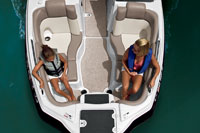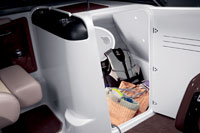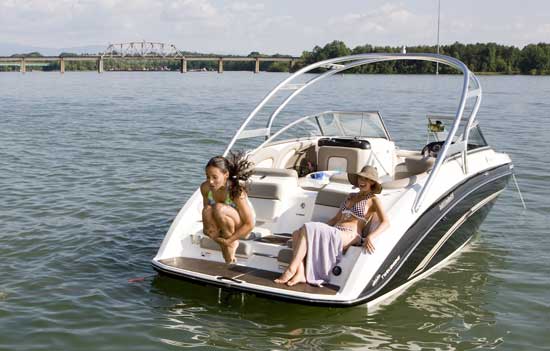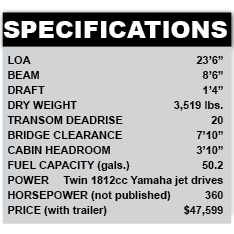Yamaha 242 Limited, a Jet-Propelled Series Design
The powertrain on the 242 Limited S truly defines this mid-sized family model.
Everything that really sets the 242 Limited S apart in the very cluttered universe of mid-price, mid-sized family boats is possible because of its inboard jet propulsion system, including its lower-than-average price.

One of four new models based on the same hull and deck, the Yamaha 242 Limited S comes with deluxe upholstery, aluminum tow sports tower with sun top (not shown here) and other extras. Top speed is about 50 mph.
This model headlines a series of four new 23-foot, six-inch Yamaha boats that share a hull, deck and twin 1.8-liter engines. Prices range from $41,799 for the SX240 to $47,599 for the fully deluxe 242 Limited S. This new 240 series replaces the 230 series models that have been award-winning best-sellers for several seasons. The new boats are about six inches longer and perhaps three inches deeper than the 230 series. Yamaha has wisely retained, and even enhanced, its signature bi-level transom design on these new boats. Thicker padded bottoms and new curved backrests on the upper section make it an area for comfortable socializing. The lower section is covered in knee-friendly Hydro-Turf material and now is just seven inches above the water surface, which eases re-boarding. Since Yamaha debuted this transom concept in 2004, other builders have tried to match it and mostly failed. It’s the low profile of the Yamaha jet drive system that makes this design possible, and impossible to execute on a sterndrive-powered boat because the engine is so much taller.

Various cushions make a variety of bow seating configurations possible. The hatch in the bow peak covers a boarding ladder and anchor stowage.
The Yamaha cockpit is conventional for this type of boat, with wrap-around bench seating aft and a bucket seat at the helm. The seat at the port console can be configured to face forward or aft in an observer position, handy as this model comes with a tow-sports tower which incorporates a sun top, three LED lamps, and a pair of small speakers. There’s a privacy compartment within the port console that has 46 inches of headroom but lacks a drain in its molded fiberglass sole. According to Yamaha, customer focus groups influenced the redesigned bow area, which is larger and comes with filler cushions that can be positioned in a variety of ways, including as a backrest across the walk-through to enable three-across lounging. There’s dedicated stowage below the starboard aft seat for a 38-quart wheeled cooler. Because it’s carpet-lined, however, the under-seat stowage may be hard to keep fresh.
The 242 has dual drive-by-wire throttles that enable two rpm-based speed-control systems. Cruise Assist can be engaged at any planing speed, while the No Wake Mode holds boat speed at about five mph. Cruise Assist lets the captain toggle up and down in eight increments to fine-tune the speed, which is great for watersports, as you can dial in a perfect speed for a wakeboarder or tuber, and then concentrate on the water ahead rather than the speedometer. This system does not, however, sync the engines, so setting the Cruise Assist with throttles synchronized is a bit tricky. The instrument display uses a built-in GPS receiver to report very accurate speed as well as position, compass heading, and real-time fuel consumption. The six-speaker Aquatic AV stereo has a docking port for an iPod. One design flaw is the location of the twin ignition keys, which are aligned directly with my left kneecap.

Add your own portable head to this large compartment in the port console, or just use it for gear stowage.
Underway at the wheel of this new Yamaha, I experienced all of the attributes, and foibles, of a jet-propelled runabout. This boat leaps out of the hole, zooming from zero to 30 mph in about seven seconds. Top speed was just over 50 mph, about the same as I measured on the 232 Limited last year. The new 1.8-liter four-cylinder engines are marine-specific. Each makes about 180 hp (Yamaha does not publish an official rating) and operate at a much lower speed than the previous 160-hp 1.0-liter engines, which were derived from a motorcycle design – WOT is 7500 rpm rather than 10,000 – so the tone from the engine bay is less frantic than on previous Yamaha boats. Of course, 7500 rpm is still about 50 percent higher engine speed than you’ll experience in a sterndrive, and produces a high-pitch tone at all speeds that I think is more tiring over the long haul. The pre-production boat I tested also produced excessive vibration and harmonic noise from the drive train, not uncommon with jets because the entire drive system is located within the boat hull, but also not typical of previous Yamaha boats. Yamaha acknowledged the issue, and told me it intends to adjust the density of the adhesives used to bond the hull, stringer and deck components, and thus better isolate the powertrain, before full production of the 240 series begins.

This bi-level transom design, a signature Yamaha feature, makes the stern area of the 242 Limited a comfortable lounge area. Lower section is close to the water for easy reboarding, and on this model covered in soft HydroTurf material.
That noise and vibration issue can be one of the disadvantages of jet-drive power compared to a sterndrive. Others include the lack of trim, which limits top speed and economy, and the lack of rudder effect at low speeds, which demands experienced boaters re-learn basic docking maneuvers. That said, the jet-drive system in the 242 Limited S offers significant advantages over a sterndrive, including a self-draining cooling system that’s easy to maintain and winterize, less mechanical complexity and less weight, very shallow draft, and the lack of propellers. No props mean there’s nothing to ding on the bottom, of course, but they also imply safety, especially to families with small children. Yamaha dealers have told me that this appearance of safety is a major selling point at boat shows, and if you are planning to do a lot of swimming off the transom, I can see where no props is a good thing.

If you like the jet concept, the 2010 Sea-Doo 230 Challenger SE comes with twin 215-hp engines and a tower for $48,899. A stern-drive runabout offering comparable style, performance, size and quality to match the new Yamaha 240 series can cost $20,000 more, and unlike the Yamaha, probably does not come with a trailer. It’s going to be tough to find another boat that matches the design and value of these new Yamaha runabouts.












